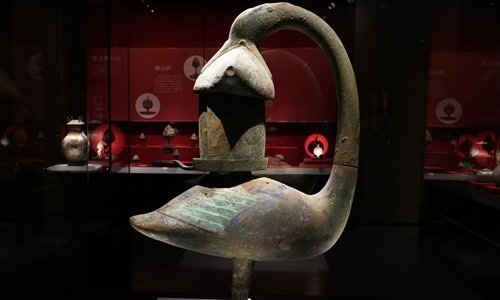HOME >> ARTS
New Shanxi Bronze Museum opens door to ancient China
By Tao Mingyang in Taiyuan Source:Global Times Published: 2019/7/29 18:13:40

Bronze vessel Basin Made by Jin Duke Photo: Tao Mingyang/GT

A reproduction of a set of ancient bronze chimes Bronze vessel Photo: Tao Mingyang/GT

Bronze vessel Lamp in the Shape of a Wild Goose with a Fish Photo: Tao Mingyang/GT

The Shanxi Bronze Museum in Taiyuan, Shanxi Province Photo: Tao Mingyang/GT
China's first provincial-level bronze museum, the Shanxi Bronze Museum opened to the public on Saturday in Taiyuan, North China's Shanxi Province.
The Shanxi Bronze Museum has more than 2,000 cultural relics on display, most of them precious cultural relics unearthed from archaeological excavations or recovered by public security organs while investigating the illegal trafficking of cultural artifacts.
Evolution of a civilization
A branch of the Shanxi Museum, the new museum is located on a small island in Taiyuan's Chengfeng Culture and Business District. It shares five connected and independent inverted cone buildings with the Taiyuan Museum.
The unique modern design of the Taiyuan Museum has earned it the nickname "instant noodle bucket" from locals and makes it one of the city's standout landmarks.
The new museum boasts an exhibition area 11,000 square meters in size. Taking Bronze Brilliance as its theme, the main display is divided into three sections that show the development and highlights of China's Bronze Age: Imprints of Chinese Civilization, The Spirit of Rites and Music and The Model of Skill and Art.
Imprints of Chinese Civilization focuses on the special role Jin (an ancient kingdom that existed in what is now Shanxi Province) culture played in the inheritance and development of Chinese civilization.
The Spirit of Rites and Music covers the distinctive features of Chinese bronze ritual vessels and their spiritual connotations. The Model of Skill and Art shows how bronzes were made in ancient times.
In addition, exhibition areas Digital Bronze and Exploring and Finding provide visitors the opportunity to experience the mystery of bronze culture in depth by means of digital and interactive educational displays.
Priceless treasures
The Bronze Age was a significant stage in human history.
China was one of the earliest civilizations to enter the Bronze Age. Archeological evidence indicates that Bronze culture had already reached maturity by the Xia Dynasty (C.2070-C.1600 BC). It reached its peak during the Shang Dynasty (C.1600BC-1046BC) to Western Zhou Dynasty (1046BC - 771BC), during which time the area that is now Shanxi was the heartland of Chinese bronze civilization.
The Shanxi bronzes on display bring back to life the main cultural currents of the Shang and Western Zhou dynasties, reflecting the progress in the evolution and development of China's ritual culture. It also shows how geographic connections helped fuse the agricultural and steppe civilizations of the time and how that impacted the design of bronzes.
Sun Qingwei, director of Peking University's Archaeology and Museology College, affirmed the important value of these Chinese bronzes.
"Previous research has proven that the method of using molds to make bronzes was learned from other cultures, but the craftsmen mixed the techniques from with local cultures to create the brilliant Chinese bronze culture," said Sun.
Sun told the Global Times that bronzes were used during important political and religious occasions as well as in people's daily lives.
"There is an old saying zhongming dingshi, which means eating using a ding [a food vessel] and playing music with zhong [a bronze bell]. This is why we can see a giant set of Bronze chimes and small tableware at the exhibition," said Sun.
"Another saying is that 'the most important things for the country are the rites and the military.' Many delicate vessels used in religious ceremonies and weapons of war are on display as well."
What's more, Sun said that he believes these bronzes can help people gain a whole new understanding of ancient times and the people they've read about in history textbooks.
"Such as the Basin Made by Jin Duke, one of the most important items in the museum. It was part of the dowry of Duke Wen of Jin's daughter," Sun said.
Duke Wen of Jin is one of the Five Hegemons that lived during Spring and Autumn Period (770BC-476BC) and was a successful leader of a strong country.
"We can see many small animals in the basin, which shows Duke Wen of Jin's soft side for his daughter instead of his role leading armies on the battlefield. The Basin Made by Jin Duke allows people to see a more realistic image of the Duke Wen of Jin and get to know his life with his family," said Sun.
Recovered relics
China's bronzes have important historic, scientific and artistic value, and are an extremely precious cultural inheritance.
At the end of 2018, an exhibition of recovered cultural relics was held at the National Museum in Beijing. According to a report from the Guangming Daily in February 2017, China has recovered about 5,000 cultural relics from criminal cases since 2013.
In the Shanxi Bronze Museum, most of the items on display are cultural relics recovered by the Shanxi Department of Public Security in 2018. A province with abundant archeological sites, Shanxi faces unique challenges when it comes to protecting cultural relics.
According to the Shanxi Department of Public Security, Shanxi Province has solved more than 1,000 cultural relic smuggling cases and recovered 27,911 precious cultural relics since 2018. Among these lost treasures, the Basin Made by Jin Duke, Wine Vessel Made by Yi and a few other bronzes on display were even recovered from abroad.
Luo Huining, the secretary of the Shanxi committee of the CPC, praised the public security organ saying that "a campaign made a museum."
Newspaper headline: Mirroring the past
Posted in: ART,CULTURE & LEISURE